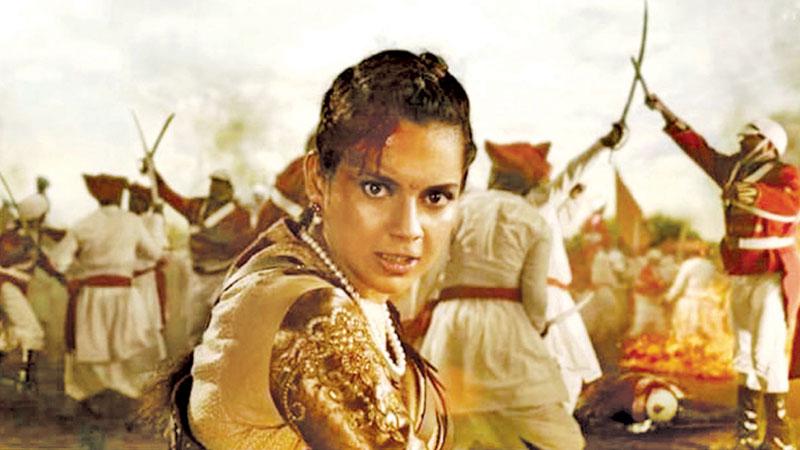
The much-hyped Hindi and Tamil versions of India’s historical and biographical film ‘Manikarnika’ is screened at the Majestic, Colombo and several other cinemas island-wide.
‘Manikarnika’ is based on the life of Rani Bai of Jhansi and her rebellion against the British East India Company. Laxmi Bai Rani of Jhansi (1828-1858) was the Queen of the princely State of Jhansi in North India. Today it is the Jhansi District in Uttar Pradesh, India. She was one of the leading figures of the Indian freedom struggle launched against the British Raj.
India’s leading actress Kangana Renaut plays the role of Queen Rani Bai of Jhansi bringing to life one of the fire brands in the Indian freedom struggle. The plot of the film is based on the uprising that took place in 1857 against the British occupation of the subcontinent. According to Nagalingam Kumarakuruparan, a Sri Lankan born columnist and author based in Hyderabad, India, the British came to India as traders but later they became the political masters of the country within a short span of time. Indians failed to check their advancement despite the tough resistance the invaders had to face.
From time immemorial India was known as a peaceful and prosperous country. India exported consumable goods such as perfumes, spices, and other items to the West that brought in a large amount of wealth. India’s fame spread throughout Europe and attracted their attention. The British who came as traders soon realized the value of its wealth of natural resources and later decided to conquer it. With this in view the British traders decided to form a trading company. Later it was named as the British East India Company. The Company made rapid progress in establishing its foothold in India. It exploited the weaknesses of Indian rulers and continued to consolidate their position. After some time, the British government took control of India replacing the British East India Company.
Uprising
The uprising against British occupation of India took a decisive turn in 1857 when the invaders were planning to consolidate their position by opening factories providing employment to natives and building laboratories for research. The new system encouraged the rich and helped the emergence of a capitalist class. However, the economic policy of the invaders further impoverished India.
Queen Rani Bai of Jhansi was in the forefront of the freedom struggle against the British. The Marathas who were the rulers of Jhansi were soldiers who loved their independence above everything else. Manikarnika was born in Varanasi on November 19, 1828. She was married to the Raja of Jhansi at the age of 15. According to tradition that prevailed at the time, she was named Luxmi Bai in honour of the Hindu Goddess Luxmi. Although she gave birth to a baby, it died after four months. Then the Raj adopted a child of his cousin. However, the Raj too died unexpectedly leaving the kingdom to Manikarnika. The British East India Company refused to recognize her as the queen. When Manikarnika remained adamant against the Company, British soldiers surrounded the Jhansi fort in March, 1858.
Manikarnika issued a proclamation, “We fight for independence. In the words of Lord Krishna, if we are victorious, we will enjoy the fruits of victory. If we are defeated or killed in the battle field, we shall surely earn eternal glory and salvation.”
Cannon fire
The declaration infuriated the British and the enemy forces began to attack the fortress with cannon fire. The rebels could not withstand the superior fire power of the British. When the walls of the fortress were breached, two columns of British soldiers entered the city and destroyed everything they could lay their hands on. Indian men, women and children resisted the advance of British soldiers with their home-made weapons. According to an eye witness, Manikarnika jumped on to a horse with her baby and escaped. She was followed by a trusted group of soldiers and maids. Meanwhile, more volunteers joined the rebellion against the British. The British forces faced the rebels commanded by Rani Manikarnika at Gwalior Fort on June 17, 1858 for the decisive battle. Manikarnika, Rani of Jhansi, dressed in battle fatigue with a sword in one hand looked like a raging goddess. Her beautiful face reddened with anger when she encountered the enemy forces.
Manikarnika was seriously wounded in the battle and her loyal body guards removed her to a safe location. However, she died within a few minutes. The British commander was keen to get her body, but it was immediately cremated. Hugh Rose, the commander of the British forces commented later that Rani Luxmi was a “clever and beautiful woman.” Perhaps he did not know that she was the most dangerous of all Indian rebel leaders. About 20 years later. Colonel Malleson in his book, “The History of the Indian Mutiny” said, “Whatever her faults in British eyes may have been, her countrymen will ever remember that she was driven by ill-treatment into rebellion, and that she lived and died for her country.”
Captivating music
The first half of the film has been directed by Krish and the second part by Kangana herself. The powerful screenplay was written by Vijendra Prasad who wrote the screenplay for ‘Bahubali.’ The captivating music has been directed by Shankar Eshaan Loy and the film is produced by Zee Studio and Kamal Jain.
‘Manikarnika’ should not be missed by anyone who values good films irrespective of the language they have been made. To break the language barrier, the film comes with apt English subtitles.
